Believe it or not, fishing tandem flies is still considered taboo to some. And it's not just to purist anglers, regulations on many streams and rivers still don't allow fishing more than one fly at a time. For the rest of us, however, fishing multiple flies has become a regularly employed way to up our chances at encountering more fish. You'll more commonly find many anglers fishing two or three nymphs than you will a single one and, on rivers throughout much of the West, hopper-dropper rigs are more ubiquitous than flat brimmed hats. What you'll see decidedly less of, however, are multi-fly rigs that pair two dry flies together. For the most part, this is without particularly good reason. In fact, one of my favorite mutli-fly rigs features two dries: tandem terrestrials.
August through October is prime terrestrial season throughout much of the country. Hatches have ground to a halt on all but the buggiest of tailwaters and as temperatures start to cool, fish are looking to fatten up for the lean days of winter that lie ahead. On most waterways, terrestrials are plentiful and offer fish a meal that is big or easy to catch — and often both. None of this is a secret to most anglers, but despite the vigor with which fish will attack a hopper floating through a riffle or a beetle swung through a tailout, you seldom see anglers doubling up and getting greedy. But why not?
Especially when the fish aren't chasing every foam and rubber-legged pattern that is smacked down on the water, fishing tandem terrestrials can be a great way to not only up your chances through sheer math — but to help decipher what land-loving insect the fish are most keyed on.
A few Augusts ago, while backcountry fishing on the Yellowstone River in Yellowstone National Park's Black Canyon, a lack of terrestrial success had us vexed. We were plying some of the fishiest runs any of us had ever seen. The river was almost entirely meadow-lined, and deep-boulder strewn runs lined the banks. We had come armed with all manner of big, beefy terrestrials — hoppers in every color and flavor, stimulators galore, Chubby Chernobyls in tan, brown, black, pink and even purple. Through each run we'd get a fat, feisty cutthroat or two to grab one of these offerings, but rarely more than that and the fishing was progressing decidedly less feverishly than we'd expected it to. We knew the fish were there, first of all because they simply had to be given where we were, and because we'd regularly see them drift up from below to inspect our bugs but refuse them. Nymphs failed to produce much more and without a mayfly or caddis spied all day, we were confounded.
Eventually, I tied a small (size 18) red-assed ant on as a trailer to a big hopper pattern and quickly got into a handful of fish in one small run. Each time the fish would grab the ant. After several others in the group duplicated my efforts and my success, we figured we had solved it — the fish wanted the ants and not the big bugs we'd be throwing at them all day.
After we fished out that run, we moved onto the next and I pared down my rig to just the ant, figuring I could get a better presentation with the ant alone and out fish my companions who were less proactive. Only, they outfished me. I managed to convince one small cutty to grab my solo ant, but the guys that still had their hopper-ant rig working were hooking up fish the same way we had in the run before. Reluctantly, I went back to the duo and was once again rewarded by a brightly colored, football-shaped trout that took the ant on my first cast with the reassembled rig.
We reasoned that the big bugs were serving as attention getters, calling hungry fish to attention, but it was the ant that was convincing them to eat. Whether that was the reality or not, the fact remained that solo hopper or solo ant rigs produced only the occasional take, while the two working together were a regular ticket to success.
Virtually all tandem terrestrial combos have potential — hopper-ant, hopper-beetle, bee-beetle (one of my personal favorites), beetle-ant and so on — so don't be afraid to experiment. And don't hesitate to fish your trailing terrestrial wet — flying ant patterns fished wet as the second fly in a two fly rig seem to work particularly well.




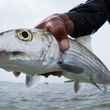
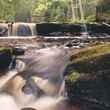
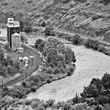




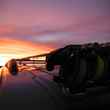



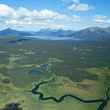
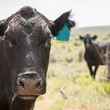




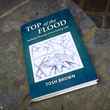



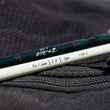





Comments
Spencer Durrant replied on Permalink
Had the same thing happen to me last weekend on the Green River in Utah.
The Green has been agonizingly slow of late. I know a couple guides who made the drift from the Flaming Gorge Dam to Little Hole without hooking up. Fishing has been tough.
I was just bank fishing, targeting some of the big fish holding in the shallows. There was a sparse mayfly hatch going, but they didn't want anything I threw at em. Eventually ended up drifting a big fat boy hopper with a mayfly emerger pattern behind it, and nailed my only fish of the day on that rig. While not two terrestrials, it's the same principle. Really interesting how it works some times.
Steve K replied on Permalink
Chad, great advice, and a REALLY beautiful photo that made my day!
Chad Shmukler replied on Permalink
Glad you enjoyed it, Steve.
Andrew Wesner replied on Permalink
I fish a lot of technical water (Metolius, Henry's Fork, unnamed Spring Creeks) and almost always fish a double rig at the beginning of hatch or when multiple hatches are occurring. I typically start with a damp emerger and a dry emerger and move up to duns as the fish progress through their feeding patterns. With multiple hatches like a BWO hatch on the heels of a PMD hatch when the weather changes, I'll fish a crippled PMD with a tiny damp PT. It's really effective. For hatches that a bit predictable I pre rig several doubles and store them on old tipper spools. Rather than dig through a fly box (and find that the bug you want to use has head cement covering the eyelet), you can hang your pre rigs on a string and put it around your neck. Timing is often critical when a hatch gets started so being ready is as important as having the right flies and making the right cast...
Fred Rickson replied on Permalink
Eyesight can be another reason to fish two flies. These days i mostly fish dry flies on Hebgen lake outside of West Yellowstone. There are two backgrounds against which you must see your fly; dark green from the pine trees, and a silver surface glare from the sky reflection. Personally, I have a hard time seeing a dark fly against the green background, or a light colored fly against a silver glare. Since you can never guess what your proper boat position should be, or where the feeding fish will show next, with one fly there is a 50:50 chance I'll be fishing the wrong color.
I only use a couple of patterns and went to two flies a number of years back to help me see what I was doing. A black parachute Adams with a light gray parachute Adams, or a black ant with a cream ant. I can always see one, while the other is always about 12 inches away. By the way, I went to all black dry flies (hoppers and stoneflies too) years ago figuring the fish, looking against the sky, see a silhouette, and black would be most visible to them. I do, however, pay a lot of attention to size and shape.
Michael Lundrigan replied on Permalink
I have been fishing tandems for years, a streamer chasing a soft hackle so using this old
British method dry makes perfect sense! Great way to improve your effort and catch trout!
Jon replied on Permalink
I could not agree more. I have been having the same experience this year in many areas. Great read. Awesome photo. Thanks
TC replied on Permalink
Just started doing the dropper rig this year and talk about a game changer. I was unaware of the taboo nature surrounding it. Its nice to read a fishing magazine article on actual fishing stuff vs Trump is the unholy one.
Pages